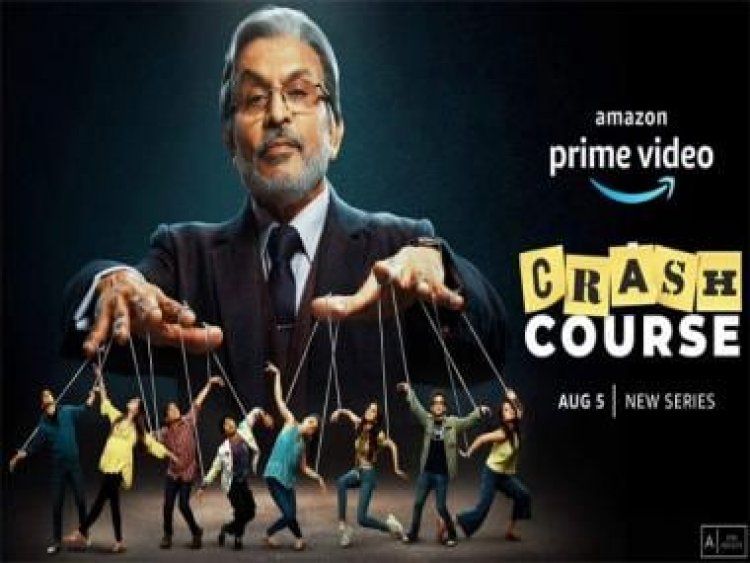Crash Course review: Edgy descendant of Kota Factory has its moments
Crash Course review: Edgy descendant of Kota Factory has its moments

In a scene from Amazon Prime Video’s Crash Course, Jindal played by a typically high-energy Annu Kapoor tells a group of employees “Topper ka game hai ye. Topper ka. I want number one”. He has just discovered that the top two ranks in JEE have been scalped by the competing Batra institute leaving his own RJ languishing in ranks ‘that no one cares about’.
A teacher tries to make the point about total numbers but is cut short. “5,500 bachon ke photo laga du kya hoarding pe?” Jindal retorts, angrily. Crash Course is a high-pitched, edgy cousin of Kota Factory that is unbothered by just how derivative it looks. But while it clearly borrows from its predecessor in spirit, it has a more adolescent vision of the city that has now become a cultural artefact of sorts. It’s not particularly revolutionary but it does have a wayward, messy energy of its own.
Crash Course is fronted by Annu Kapoor, a third-generation businessman with a vague plan to rule Kota. His institute is in direct competition with the Batras, run by a brother duo who have gone against their father’s vision to execute education as charity. While this represents the surface, beneath, there are of course the students. Some of them look too close to characters from Kota Factory, while others are instantly forgettable as gimmicky teenagers.
There are some hairy overlaps with the other show, including a maverick physics teacher, some unobvious spatial similarities and the sheer pedigree of that former show weighing down on new characters straining to be different but looking like echoes of Vaibhav, Meena and the others. What works for Crash Course, however, is that it doesn’t relegate its kids to a cocoon of pre-pubertal restrictions.
In Crash Course, the kids date, go to rave parties, have sex and do drugs. It would be naïve to call it progressive, but the series simply chooses to claw at spaces that Kota Factory was happy to vacate. There are odd love stories here, age-inappropriate crushes and of course the disarming sex between teenagers. Sexuality here isn’t painted as a form of depravity, but a natural process. It’s overacted at times, but it isn’t placed for shock and awe. It’s unrealistic to think that a town teeming with anxious teenagers don’t get greasy. To which effect Kota Factory’s sterilised view of the town, though aesthetically innovative, comes across as a departure from reality. But then that is TVF’s clean-screen forte.
Crash Course, on the other hand, is happy to look noir-esque and sound unprincipled. There are no good men in the business of education, and it is perhaps a side of the Kota story that needed telling. The kids with the exception of Anil (played by Mohit Solanki) are passable. There but rarely as memorable as the ones from its unassuming but effective predecessor. The show instead really belongs to Kapoor whose use of the vernacular really powers a despotic selfishness to claim the city at all costs. It’s scary, the nihilistic brutality with which Jindal takes calls for his
own personal selfish interest. He has no kids of his own but is motivated by a generational dream and it represents, subtly, India’s wounded legacies.
The idea that so many of today’s cronies have built themselves on seething anger against the poverty they were born into. The kind that inures you to suffering as a point of inspiration. Kapoor is majestic and unhinged even if somewhat reminiscent of his own previous roles.
The series has a few things going for itself but it does, on paper at least, come across as an imitative cousin of Kota Factory. Only its syntax is different, its narrative edgier and akin to pulp. To which, the series often overplays its hand at its skittish, often hypnotic world of unbridled teenagers. The rave parties seem forced, the camaraderie inorganic, and the impetus on banter can often relegate the education to an afterthought. The series can often start to feel like a campy teenage drama that doesn’t have a clue about what to do between its salacious, exaggerated borders. At one point in the show, A.K, a bohemian teacher in the vein of Factory’s Jeetu Bhaiya, does a whole light-and-sound show to explain Sinusoidal waves. It’s a horribly miscalculated gimmick that tonally downgrades the intended intellectualism of a show that though set in a town about education, often forgets to get the academic bits right.
The Prime Video series isn’t a patch on the originality of Kota Factory, but in the inherited space of conversations around India’s famed education hubs, it’s a show that at least dresses down than up. It exposes the hairy side of the ‘business’ of education without, especially, the apologetic modesty of its predecessors. This ugly side of cronyism it happily embraces. Crash Course also doesn’t condescendingly rob its teenagers of sexual angst or agency. The only real problem is that the series exaggerates, often to unrealistic effect, the dramatism of a show that could have been helped by buckling down on its essentials. Instead it is part soap, part gritty business drama and part forgettable teenage blast.
The author writes on art and culture, cinema, books, and everything in between. Views expressed are personal.
Read all the Latest News, Trending News, Cricket News, Bollywood News,
India News and Entertainment News here. Follow us on Facebook, Twitter and Instagram
What's Your Reaction?


























































